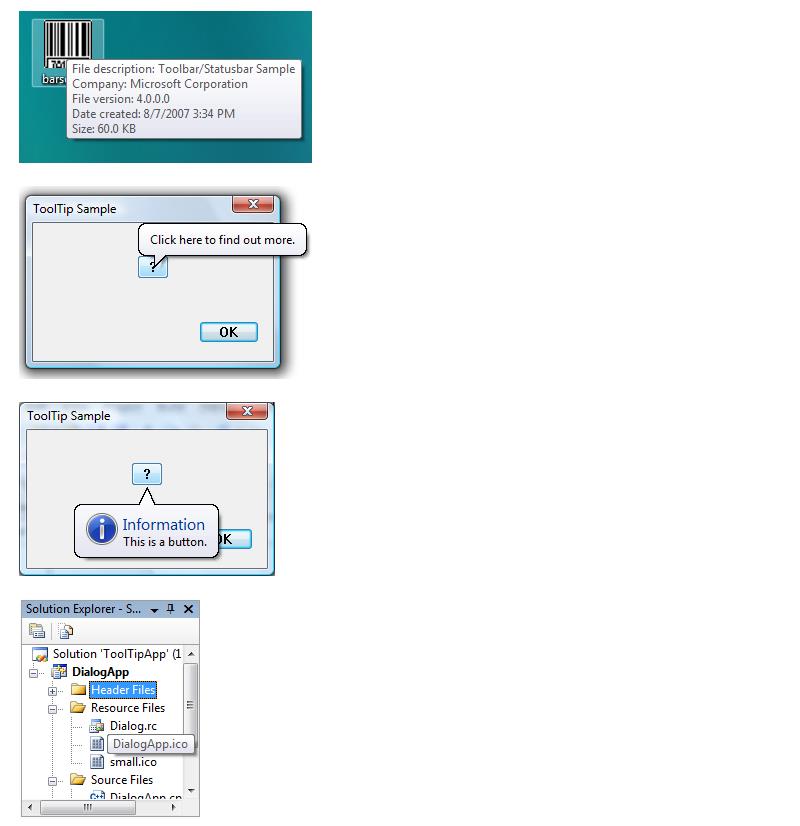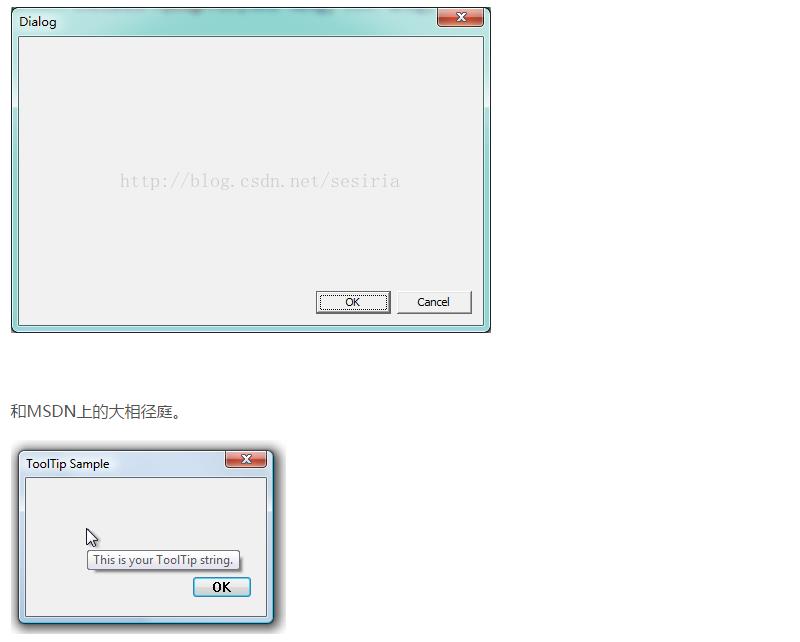Windows ToolTips简要介绍(转)
Posted ~小小鸟~
tags:
篇首语:本文由小常识网(cha138.com)小编为大家整理,主要介绍了Windows ToolTips简要介绍(转)相关的知识,希望对你有一定的参考价值。
原文转自 https://blog.csdn.net/sesiria/article/details/77450151
Windows 标准控件ToolTips简要介绍
参考文档 MSDN
https://msdn.microsoft.com/en-us/library/ff486072(v=vs.85).aspx
一,什么是ToolTips
ToolTips 就是一个类似于一个悬浮的文本框,在鼠标指针移动上去能显示特定的文本。

各种ToolTips样式。
二,创建ToolTips
HWND hwndTip = CreateWindowEx(NULL, TOOLTIPS_CLASS, NULL, WS_POPUP | TTS_NOPREFIX | TTS_ALWAYSTIP, CW_USEDEFAULT, CW_USEDEFAULT, CW_USEDEFAULT, CW_USEDEFAULT, hwndParent, NULL, hinstMyDll, NULL); SetWindowPos(hwndTip, HWND_TOPMOST,0, 0, 0, 0, SWP_NOMOVE | SWP_NOSIZE | SWP_NOACTIVATE);
此后ToolTips的窗口函数自动维护Tooltips的尺寸,位置和显示隐藏状态等。 ToolTips的高度基于所设置的字体的高度。
1.激活ToolTips
Tooltips可以处于激活和未激活的状态。激活状态下ToolTips会显示文本。 当ToolTips未激活,其文本讲不被显示。即使鼠标指针放在一个Tools上发送TTM_ACTIVE可以激活和关闭激活一个ToolTips的状态。
2.将ToolTips关联Tools
创建一个TOOLINFO的结构体对象,设置uID为关联工具的ID
设置uFlags为 TTF_IDISHWND
并发送TTM_ADDTOOL消息给ToolTips的句柄。后面的完整的例子。
3.显示文本
默认使用TOOLINFO的 lpszText为显示问题。 可以发送TTM_UPDATETIPTEXT消息来更新显示值。
如果将lpszText 设置为 LPSTR_TEXTCALLBACK ToolTips需要显示文本时候,会Call之前注册的父窗口句柄的窗口函数并发送 TTN_GETDISPINFO通知码,
该消息包含了指向NMTTDISPINFO 结构的指针用于修改相应的文本,以供后续显示使用。
4.消息和通知
windows默认只发送消息给包含鼠标指针的窗口,并不会发送消息给ToolTips。因此需要关联ToolTips和其对应的父窗口活控件ID来控制其显示(恰当的位置和恰当的时间)。
ToolTips会自动处理一下的消息。
1.通过TOOLINFO绑定过的控件或者父窗口的矩形区域。
2.绑定ToolTip的父窗口在同一个线程内。
满足以上两个条件 将TOOLINFO的uFlags设置为 TTF_SUBCLASS 然后发送TTM_ADDTOOL消息给Tooltip的句柄。 但是ToolTips和关联的窗口必须有直接的消息通路。也就是父窗口和子窗口的关系。 如果你关联了别的进程的窗口,还是收不到消息的。可能要使用HOOK。此时你应该发送TTM_RELAYEVENT消息给tooltip 参考Tracking Tooltip
当Tooltip要显示的时候会发送给其拥有者窗口TTN_SHOW通知码。 TTN_POP表明Tooltip即将要隐藏。 通过WM_NOTIFY消息发送。
三,ToolTips应用
1.一个简单的ToolTips的例子
#include <windows.h> #include <windowsx.h> #include <commctrl.h> #include "resource.h" #pragma comment(lib, "comctl32.lib") LRESULT CALLBACK MyDlgProc(HWND, UINT, WPARAM, LPARAM); HINSTANCE g_hInst; HWND hTTWnd; int APIENTRY WinMain(HINSTANCE hInstance, HINSTANCE, LPSTR, int) { g_hInst = hInstance; INITCOMMONCONTROLSEX cx = { sizeof(INITCOMMONCONTROLSEX), ICC_BAR_CLASSES }; BOOL ret = InitCommonControlsEx(&cx); return DialogBox(hInstance, MAKEINTRESOURCE(IDD_DIALOG1), NULL, (DLGPROC)MyDlgProc); } // Description: // Creates a tooltip for an item in a dialog box. // Parameters: // idTool - identifier of an dialog box item. // nDlg - window handle of the dialog box. // pszText - string to use as the tooltip text. // Returns: // The handle to the tooltip. // HWND CreateToolTip(int toolID, HWND hDlg, PTSTR pszText) { if (!toolID || !hDlg || !pszText) { return FALSE; } // Get the window of the tool. HWND hwndTool = GetDlgItem(hDlg, toolID); // Create the tooltip. g_hInst is the global instance handle. HWND hwndTip = CreateWindowEx(NULL, TOOLTIPS_CLASS, NULL, WS_POPUP | TTS_ALWAYSTIP | TTS_BALLOON, CW_USEDEFAULT, CW_USEDEFAULT, CW_USEDEFAULT, CW_USEDEFAULT, hDlg, NULL, g_hInst, NULL); if (!hwndTool || !hwndTip) { return (HWND)NULL; } // Associate the tooltip with the tool. TOOLINFO toolInfo = { 0 }; toolInfo.cbSize = sizeof(toolInfo); toolInfo.hwnd = hDlg; toolInfo.uFlags = TTF_IDISHWND | TTF_SUBCLASS; toolInfo.uId = (UINT_PTR)hwndTool; toolInfo.lpszText = pszText; SendMessage(hwndTip, TTM_ADDTOOL, 0, (LPARAM)&toolInfo); return hwndTip; } void CreateToolTipForRect(HWND hwndParent) { // Create a tooltip. HWND hwndTT = CreateWindowEx(WS_EX_TOPMOST, TOOLTIPS_CLASS, NULL, WS_POPUP | TTS_NOPREFIX | TTS_ALWAYSTIP, CW_USEDEFAULT, CW_USEDEFAULT, CW_USEDEFAULT, CW_USEDEFAULT, hwndParent, NULL, g_hInst, NULL); SetWindowPos(hwndTT, HWND_TOPMOST, 0, 0, 0, 0, SWP_NOMOVE | SWP_NOSIZE | SWP_NOACTIVATE); // Set up "tool" information. In this case, the "tool" is the entire parent window. TOOLINFO ti = { 0 }; ti.cbSize = sizeof(TOOLINFO); ti.uFlags = TTF_SUBCLASS; ti.hwnd = hwndParent; ti.hinst = g_hInst; ti.lpszText = TEXT("This is your tooltip string."); GetClientRect(hwndParent, &ti.rect); // Associate the tooltip with the "tool" window. SendMessage(hwndTT, TTM_ADDTOOL, 0, (LPARAM)(LPTOOLINFO)&ti); } LRESULT CALLBACK MyDlgProc(HWND hDlg, UINT uMsg, WPARAM wParam, LPARAM lParam) { switch (uMsg) { case WM_INITDIALOG: { CreateToolTipForRect(hDlg); break; } case WM_CLOSE: EndDialog(hDlg, FALSE); break; } return FALSE; }
这个代码很简单就是在Windows对话框上显示ToolTips。可是编译以后死活不显示,初始化InitCommonControlsEx的调用也没有问题。观察到自己创建的对话框风格非常复古。

后来查阅相关资料。这是由于项目缺少了Manifest定义。在网上找了一个Manifest的定义文件在项目加载此文件就解决了此问题。关于Manifest文件的定义参考此文章
MSDN: Enable Visual Style in your program.
https://msdn.microsoft.com/en-us/library/windows/desktop/bb773175(v=vs.85).aspx#no_extensions
Windows.Manifest定义如下
<?xml version="1.0" encoding="UTF-8" standalone="yes"?> <assembly xmlns="urn:schemas-microsoft-com:asm.v1" manifestVersion="1.0"> <assemblyIdentity name="Microsoft.Windows.XXXX" processorArchitecture="x86" version="5.1.0.0" type="win32"/> <description>Windows Shell</description> <dependency> <dependentAssembly> <assemblyIdentity type="win32" name="Microsoft.Windows.Common-Controls" version="6.0.0.0" processorArchitecture="x86" publicKeyToken="6595b64144ccf1df" language="*" /> </dependentAssembly> </dependency> </assembly>
运行结果如下。

关于这个问题深入研究发现,是调用TOOLINFOW类的时候如果程序加载Common Control 6.0以下的版本,这个结构体的定义的实际size比6.0少4个字节。
而ANSI版本无此问题。如果使用Unicode版本必须加入manifest强制让应用程序加载common Control 6.0才能使用sizeof(TOOLINFOW)的返回值。
否则就要将此值减去4
参考此文章: https://stackoverflow.com/questions/2545682/unicode-tooltips-not-showing-up/15173051
2. 一个指定位置显示Tooltip的例子 同时显示2个Tooltip并且自己定位Toolpis的位置。
#include <windows.h> #include <windowsx.h> #include <commctrl.h> #include "resource.h" #pragma comment(lib, "comctl32.lib") LRESULT CALLBACK MyDlgProc(HWND, UINT, WPARAM, LPARAM); HINSTANCE g_hInst; HWND hTTWnd; HWND g_hwndTrackingTT; HWND g_hwndTrackingTT1; TOOLINFO g_toolItem; BOOL g_TrackingMouse; int APIENTRY WinMain(HINSTANCE hInstance, HINSTANCE, LPSTR, int) { g_hInst = hInstance; INITCOMMONCONTROLSEX cx = { sizeof(INITCOMMONCONTROLSEX), ICC_BAR_CLASSES }; BOOL ret = InitCommonControlsEx(&cx); return DialogBox(hInstance, MAKEINTRESOURCE(IDD_DIALOG1), NULL, (DLGPROC)MyDlgProc); } // Description: // Creates a tooltip for an item in a dialog box. // Parameters: // idTool - identifier of an dialog box item. // nDlg - window handle of the dialog box. // pszText - string to use as the tooltip text. // Returns: // The handle to the tooltip. // HWND CreateToolTip(int toolID, HWND hDlg, PTSTR pszText) { if (!toolID || !hDlg || !pszText) { return FALSE; } // Get the window of the tool. HWND hwndTool = GetDlgItem(hDlg, toolID); // Create the tooltip. g_hInst is the global instance handle. HWND hwndTip = CreateWindowEx(NULL, TOOLTIPS_CLASS, NULL, WS_POPUP | TTS_ALWAYSTIP | TTS_BALLOON, CW_USEDEFAULT, CW_USEDEFAULT, CW_USEDEFAULT, CW_USEDEFAULT, hDlg, NULL, g_hInst, NULL); if (!hwndTool || !hwndTip) { return (HWND)NULL; } // Associate the tooltip with the tool. TOOLINFO toolInfo = { 0 }; toolInfo.cbSize = sizeof(toolInfo); toolInfo.hwnd = hDlg; toolInfo.uFlags = TTF_IDISHWND | TTF_SUBCLASS; toolInfo.uId = (UINT_PTR)hwndTool; toolInfo.lpszText = pszText; SendMessage(hwndTip, TTM_ADDTOOL, 0, (LPARAM)&toolInfo); return hwndTip; } void CreateToolTipForRect(HWND hwndParent) { // Create a tooltip. HWND hwndTT = CreateWindowEx(WS_EX_TOPMOST, TOOLTIPS_CLASS, NULL, WS_POPUP | TTS_NOPREFIX | TTS_ALWAYSTIP, CW_USEDEFAULT, CW_USEDEFAULT, CW_USEDEFAULT, CW_USEDEFAULT, hwndParent, NULL, g_hInst, NULL); SetWindowPos(hwndTT, HWND_TOPMOST, 0, 0, 0, 0, SWP_NOMOVE | SWP_NOSIZE | SWP_NOACTIVATE); // Set up "tool" information. In this case, the "tool" is the entire parent window. TOOLINFO ti = { 0 }; ti.cbSize = sizeof(TOOLINFO); ti.uFlags = TTF_SUBCLASS; ti.hwnd = hwndParent; ti.hinst = g_hInst; ti.lpszText = TEXT("This is your tooltip string."); GetClientRect(hwndParent, &ti.rect); // Associate the tooltip with the "tool" window. SendMessage(hwndTT, TTM_ADDTOOL, 0, (LPARAM)(LPTOOLINFO)&ti); } HWND CreateTrackingToolTip(int toolID, HWND hDlg, WCHAR* pText) { // Create a tooltip. HWND hwndTT = CreateWindowEx(WS_EX_TOPMOST, TOOLTIPS_CLASS, NULL, WS_POPUP | TTS_NOPREFIX | TTS_ALWAYSTIP | TTS_BALLOON, CW_USEDEFAULT, CW_USEDEFAULT, CW_USEDEFAULT, CW_USEDEFAULT, hDlg, NULL, g_hInst, NULL); if (!hwndTT) { return NULL; } // Set up the tool information. In this case, the "tool" is the entire parent window. g_toolItem.cbSize = sizeof(TOOLINFO); g_toolItem.uFlags = TTF_IDISHWND | TTF_TRACK | TTF_ABSOLUTE; g_toolItem.hwnd = hDlg; g_toolItem.hinst = g_hInst; g_toolItem.lpszText = pText; g_toolItem.uId = (UINT_PTR)hDlg; GetClientRect(hDlg, &g_toolItem.rect); // Associate the tooltip with the tool window. SendMessage(hwndTT, TTM_ADDTOOL, 0, (LPARAM)(LPTOOLINFO)&g_toolItem); return hwndTT; } LRESULT CALLBACK MyDlgProc(HWND hDlg, UINT uMsg, WPARAM wParam, LPARAM lParam) { switch (uMsg) { case WM_INITDIALOG: { g_hwndTrackingTT = CreateTrackingToolTip(0, hDlg, L""); g_hwndTrackingTT1 = CreateTrackingToolTip(0, hDlg, L""); break; } case WM_MOUSELEAVE: SendMessage(g_hwndTrackingTT, TTM_TRACKACTIVATE, (WPARAM)FALSE, (LPARAM)&g_toolItem); SendMessage(g_hwndTrackingTT1, TTM_TRACKACTIVATE, (WPARAM)FALSE, (LPARAM)&g_toolItem); g_TrackingMouse = FALSE; return FALSE; case WM_MOUSEMOVE: static int oldX, oldY; int newX, newY; if (!g_TrackingMouse) // The mouse has just entered the window. { // Request notification when the mouse leaves. TRACKMOUSEEVENT tme = { sizeof(TRACKMOUSEEVENT) }; tme.hwndTrack = hDlg; tme.dwFlags = TME_LEAVE; TrackMouseEvent(&tme); // Activate the tooltip. SendMessage(g_hwndTrackingTT, TTM_TRACKACTIVATE, (WPARAM)TRUE, (LPARAM)&g_toolItem); SendMessage(g_hwndTrackingTT1, TTM_TRACKACTIVATE, (WPARAM)TRUE, (LPARAM)&g_toolItem); g_TrackingMouse = TRUE; } newX = GET_X_LPARAM(lParam); newY = GET_Y_LPARAM(lParam); // Make sure the mouse has actually moved. The presence of the tooltip // causes Windows to send the message continuously. if ((newX != oldX) || (newY != oldY)) { oldX = newX; oldY = newY; // Update the text. WCHAR coords[12]; wsprintf(coords, TEXT("%d, %d"), newX, newY); g_toolItem.lpszText = coords; SendMessage(g_hwndTrackingTT, TTM_SETTOOLINFO, 0, (LPARAM)&g_toolItem); SendMessage(g_hwndTrackingTT1, TTM_SETTOOLINFO, 0, (LPARAM)&g_toolItem); // Position the tooltip. The coordinates are adjusted so that the tooltip does not overlap the mouse pointer. //POINT pt = { newX, newY }; POINT pt = { 50, 50 }; ClientToScreen(hDlg, &pt); SendMessage(g_hwndTrackingTT, TTM_TRACKPOSITION, 0, (LPARAM)MAKELONG(pt.x + 10, pt.y - 20)); SendMessage(g_hwndTrackingTT1, TTM_TRACKPOSITION, 0, (LPARAM)MAKELONG(pt.x + 100, pt.y - 20)); } return FALSE; case WM_CLOSE: EndDialog(hDlg, FALSE); break; } return FALSE; }